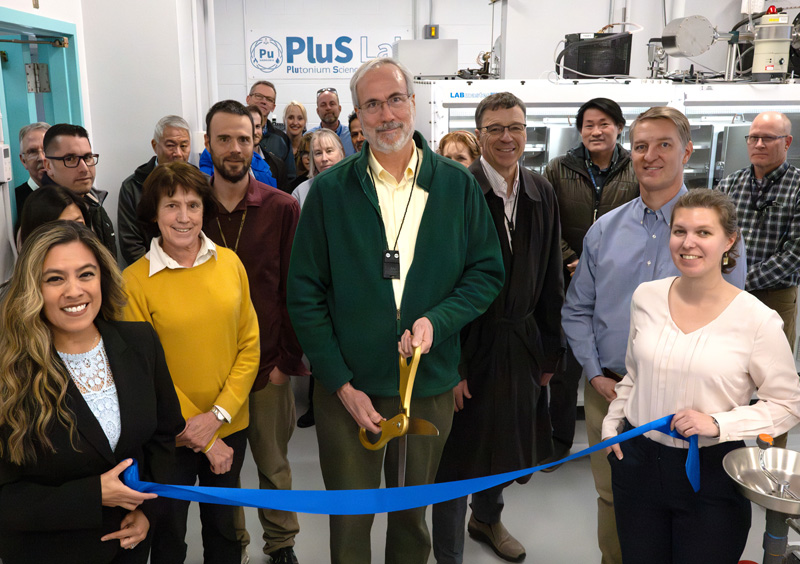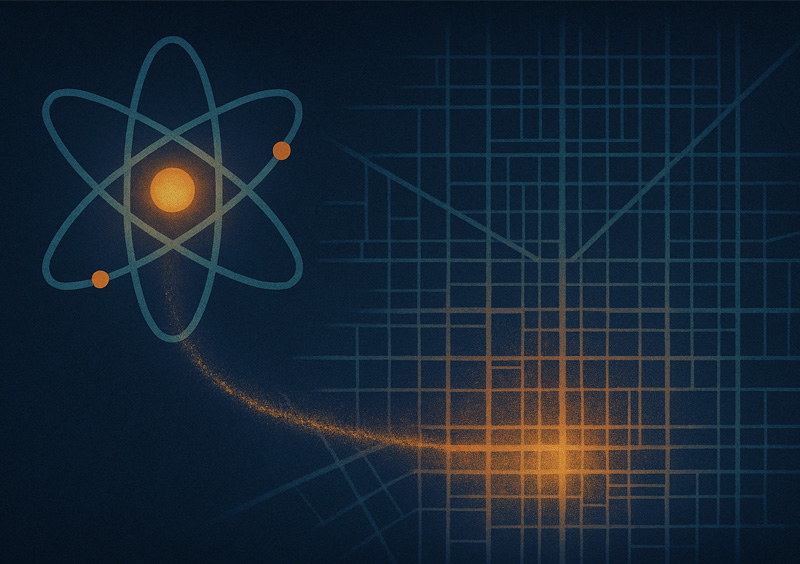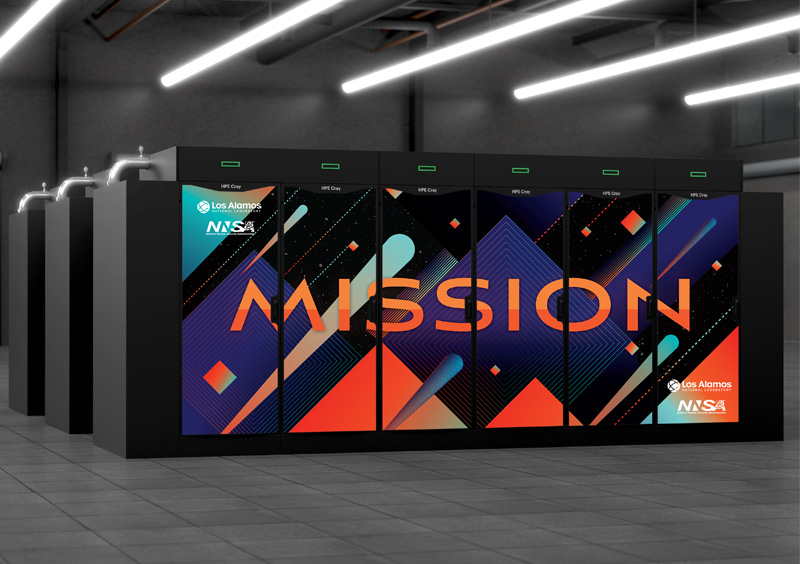A Los Alamos collaboration has replicated an important but largely forgotten physics experiment: the first deuterium-tritium (DT) fusion observation. As described in Physical Review C, the reworking of the previously unheralded experiment confirmed the role of University of Michigan physicist Arthur Ruhlig, whose 1938 experiment and observation of deuterium-tritium fusion likely planted the seed for a physics process that informs national security work and nuclear energy research to this day.
“As we’ve uncovered, Ruhlig’s contribution was to hypothesize that DT fusion happens with very high probability when deuterium and tritium are brought sufficiently close together,” said Mark Chadwick, associate Laboratory director for Science, Computation and Theory at Los Alamos. “Replicating his experiment helped us interpret his work and better understand his role, and what proved to be his essentially correct conclusions. The course of nuclear fuel physics has borne out the profound consequences of Arthur Ruhlig’s clever insight.”
The DT fusion reaction is central to enabling fusion technologies, whether as part of the nation’s nuclear deterrence capabilities or in ongoing efforts to develop fusion for civilian energy. For instance, the deuterium-tritium reaction is at the center of efforts at the National Ignition Facility to harness fusion. Los Alamos physicists developed a theory about where the idea came from — Ruhlig — and then built an experiment that would confirm the import and accuracy of Ruhlig’s suggestion.
Tracking down the origin of DT fusion
In 2023, Chadwick was working with colleagues, including theoretical physicist Mark Paris, on a compendium of the early history of the development of fusion. A reasonably well-known part of that history is the suggestion — at a meeting at future Manhattan Project-director J. Robert Oppenheimer’s July 1942 Berkeley physics conference — by physicist Emil Konopinski that DT fusion, among numerous possible fusion reactions, would be particularly advantageous as a component of a fission-reaction weapon.
But Chadwick and his Los Alamos colleagues wondered: How did Konopinski arrive at this insight about DT fusion? Seizing on the most viable fusion process among several options this early in the program — the Manhattan Project had started in earnest only months before — certainly proved a fortuitous decision.
Searching the National Security Research Center archive one night, Chadwick came across a 1986 audio recording of Konopinski recounting the decision making around deuterium-tritium reactions. (The team made the Konopinski recording available on YouTube.) His voice coming out of the past, reflecting on an even further past, Konopinski several times attributed his motivation to explore deuterium-tritium research to his knowledge of “pre-war” research.
Tritium was discovered in 1934 by experimental physicist Ernest Rutherford’s team. Rutherford was a titan of early physics, having advanced the model of the atom with Neils Bohr, and also having overseen work by James Chadwick to discover the neutron. Starting with 1934, Paris scoured the published physics literature, eventually coming across Ruhlig’s single-author, 1938 letter to the editor published in Physical Review about a gamma-ray experiment.
Ruhlig was working with deuterium-on-deuterium interactions: blasting deuterium with a beam of deuterons and studying gamma-ray effects. (A deuteron is the nucleus — one neutron and one proton — of a deuterium atom.) In what is nearly an aside in the final paragraph of the letter, Ruhlig described observing protons with extremely high energies, inferring that they were generated by secondary reactions: tritium-on-deuterium fusion neutrons scattering protons out of a thin cellophane foil placed inside a cloud chamber. He cited a private conversation with Hans Bethe in unpacking what he’d seen. The DT reaction “must be an exceedingly probable one,” he concluded, offering a quantitative estimate of one in 1,000 energetic protons against lower-energy protons.
And there the matter dropped; Ruhlig’s paper was infrequently cited, with the few citations bearing mostly on the gamma-ray issues. But Konopinski appears to have remembered the work.
Paris and Chadwick put together the pieces: As it happens, Ruhlig and Konopinski were both University of Michigan students, overlapping in their doctoral studies in the 1930s. Ruhlig’s thesis adviser, Richard Crane, was a colleague of Bethe, and Konopinski served on a research fellowship overseen by Bethe. They also shared a mentor in University of Michigan physicist George Uhlenbeck, co-discoverer of electron spin. And though Ruhlig’s paper was not often cited, that does not necessarily mean it was unknown — the journal would have been part of many physicists’ regular reading.
“The evidence for Konopinski interpreting and taking up Ruhlig’s suggestion of the probability of DT fusion is circumstantial, but nonetheless strong,” Paris said. “We’re left to ask, what did Ruhlig actually observe? Are his conclusions consistent with what we would arrive at with a computational approach and an understanding of modern cross sections? Ultimately, the way to answer those remaining questions is to replicate the experiment.”
Chadwick mentioned the Ruhlig paper, and their theories about the 1938 experiment’s role in the development of DT fusion, to Lab Director Thom Mason, who insisted on the team conducting an experiment — not just a simulation — to validate their conclusions.
Replicating the experiment
The team collaborated with experimental physicists from Duke University, based at the Triangle Universities Nuclear Laboratory in North Carolina, to replicate Ruhlig’s work with a modern, rigorously executed duplication of the original experiment. The reproduction would be accompanied by theoretical and computational analysis.
The team used the laboratory’s Tandem accelerator at its lowest operating power, producing a 3.5-mm deuteron beam. They paired that beam with a thin, cobalt-alloy foil between the accelerator vacuum and target that effectively duplicated as best as possible Ruhlig’s 500 keV beam. As in 1938, the beam was directed at a target of deuterated phosphoric acid, with a liquid scintillator neutron detector tracking the neutrons of interest to gauge the secondary reactions.
“In contrast to fusion experiments such as in the inertial confinement fusion efforts at the National Ignition Facility, we were able to perform, for the first time at a low-energy nuclear physics facility, a DT fusion experiment as a secondary reaction following the initial deuterium-deuterium interaction which provides the tritium,” said Werner Tornow, Duke University physicist for the Triangle Universities Nuclear Laboratory. “This work helps answer some intriguing questions about physics history, but it’s also impactful in extending our ability to work with DT fusion in a considerably more challenging environment.”
Confirming Ruhlig’s essential observations
In analyzing their results, the modern experiment did observe secondary DT reactions, although it also suggests that Ruhlig overestimated the ratio at which he was seeing excess neutron production, the products of fusion; the researchers detected a much smaller ratio. As Ruhlig’s 1938 letter describing the experiment provides only sparse details as to how he arrived at his determination, though, it is ultimately difficult to decisively gauge the Michigan physicist’s accuracy against the modern results. The team’s calculated value using modern methods did agree with the measure value gleaned from the replicated experiment.
Importantly, the measurements derived from the experimental techniques employed by Ruhlig and re-tested by the Los Alamos and Triangle Universities Nuclear Laboratory researchers can be applied to active fusion efforts such as at NIF.
“Regardless of the inconsistency of Ruhlig’s rate of fusion against our modern understanding, our replication leaves no doubt that he was at least qualitatively correct when he said that DT fusion was ‘exceedingly probable,’” Chadwick said. “Ruhlig’s accidental observation of DT fusion, together with subsequent Manhattan Project cross section measurements, contributed to the peaceful application of DT fusion in tokamaks focused on energy projects and in inertial confinement fusion experiments like NIF. I think we’re all proud to lift Arthur Ruhlig up again out of history as an important contributor to ongoing, vital research.”
Notably, the team published its results in Physical Review — the same journal that published Ruhlig’s first observation of DT fusion in 1938.
Paper: “Modern version of the uncited 1938 experiment that first observed DT fusion.” Physical Review C. DOI: 10.1103/PhysRevC.111.064618
Paper: “A lost detail in D-T fusion history.” Physics Today. DOI: 10.1063/PT.3.5317
Paper: “Early nuclear fusion cross-section advances 1934-1952 and comparison to today’s ENDF data.” Fusion Science and Technology. DOI: 10.1080/15361055.2023.2297128

Arthur J. Ruhlig: A Physics Life
While Arthur (Art) Ruhlig never received wide acclaim for his initial observation of deuterium-tritium fusion, he was an important contributor to essential physics for many years. Born June 13, 1912, in Michigan, he graduated from high school in Fort Wayne, Indiana, before setting off for the University of Michigan. Studying under H. Richard Crane, Ruhlig was awarded a doctorate in physics in January 1938 for his thesis, “The Passage of Fast Electrons and Positrons Through Lead.” Ruhlig’s critical publication in Physical Review, “Search for Gamma-Rays from the Deuteron-Deuteron Reaction,” with its observation of DT fusion, followed in August of that year.

Ruhlig’s career spanned government and private industry research across a few disciplines. He joined the Naval Research Laboratory in 1940 as an electrical engineer, and he was with the Laboratory for more than 15 years. In 1946, he was with the Rocket Sonde Research Branch, an arm of the Naval Research Laboratory charged with developing rocketry that uses instruments to study the atmosphere. He went on to become the branch head first of the radiation division and then the electron tubes group. Much of his work from this time was and remains classified, though he occasionally published in open literature.
In a serendipitous turn, Ruhlig was a member of a Naval Research Laboratory team that supported Los Alamos’ 1951 Operation Greenhouse in the Pacific. Ruhlig led a diagnostic group responsible for amplifiers and transmission lines. Having been the first to observe DT fusion in 1938, he was thus among the first to observe ignited burning fusion plasma as deployed in the series of thermonuclear tests. Ruhlig developed a formula, widely used for decades, to infer the temperature of a burning plasma from the observed neutron spectrum.
In 1956, Ruhlig joined the engineering and research company Aeronutronic (later purchased by Ford and merged with Philco), managing a radar and electronics laboratory. In 1960, Ruhlig was named manager of physics and computing for what was now the Aeronutronic division of Ford Motor Company in Newport Beach, California, and then in 1961 was named a senior staff scientist. The company noted Ruhlig’s “wide-ranging competence” on display during his tenure there in the 1960s, including his valuable role in developing a laser system proposal for the U.S. Air Force. He could fluently read in German, French and Russian and was praised as a “brilliant scientist,” whose “company loyalty and (…) personal and professional integrity are of the highest order.”
A family-oriented man, Ruhlig married his wife, Emily, in 1934, and they were married for nearly 67 years before her death in 2001. Arthur Ruhlig died in 2003 in Santa Ana, California. The Los Alamos-Duke University research team replicating the experiment connected with Ruhlig’s daughter Vivian Lamb, living in North Carolina. She had been searching family history to share with her granddaughter, and, seeing the team’s request for information about Ruhlig online, reached out to the research team and graciously shared her time and memories. She also passed along a picture of her hardworking father, likely from sometime following his 1938 work — a portrait of, in Vivian’s words, the “consummate scientist,” one who paired a “lifelong curiosity about problems in physics” with abiding “respect for careful scientific experiments.”
LA-UR-25-25762






